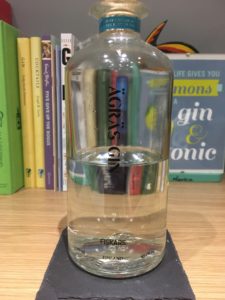 Today’s gin hails from Finland; the Ägräs gin distillery is in Fiskars Village, an old ironworks village 88km west of Helsinki. The distillery takes it’s name from the ancient Finnish god of vegetation, and they use just four botanicals (juniper, red clover, angelica and lemon peel) sourced from the forests of Finland. The distillery is the first crowdfunded distillery in Finland, with over 500 shareholders and now make their gin, an Akvavit, and the limited edition Abloom gin which takes their standard gin mixed with hibiscus flowers and honey.
Today’s gin hails from Finland; the Ägräs gin distillery is in Fiskars Village, an old ironworks village 88km west of Helsinki. The distillery takes it’s name from the ancient Finnish god of vegetation, and they use just four botanicals (juniper, red clover, angelica and lemon peel) sourced from the forests of Finland. The distillery is the first crowdfunded distillery in Finland, with over 500 shareholders and now make their gin, an Akvavit, and the limited edition Abloom gin which takes their standard gin mixed with hibiscus flowers and honey.
cocktail
Avva Gin
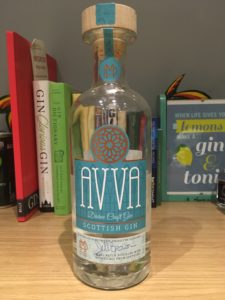 I’ve admired the bottle of Avva gin for a while, and truth be told it’s been sat on my shelf for nearly two years thanks to my old housemate bringing me a bottle home from one of her events. Based in the old cathedral city of Elgin (up the top near Lossiemouth) the Moray Distillery uses botanicals selected from the highlands and Speyside (including red clover, dandelion and nettle) to create their small batch gin. Avva means a respected grandmother from the Indian language of Dravidian, but in Hebrew it means to overturn or ruin – combined they make a nod to the traditional mother’s ruin reputation. Their still is made in Speyside and is named Jessie Jean after the founder’s grandmothers. The love of the local area continues into their branding, the label features the ‘rose window’ which is an idea of how the cathedral’s round window would have looked when it was still standing.
I’ve admired the bottle of Avva gin for a while, and truth be told it’s been sat on my shelf for nearly two years thanks to my old housemate bringing me a bottle home from one of her events. Based in the old cathedral city of Elgin (up the top near Lossiemouth) the Moray Distillery uses botanicals selected from the highlands and Speyside (including red clover, dandelion and nettle) to create their small batch gin. Avva means a respected grandmother from the Indian language of Dravidian, but in Hebrew it means to overturn or ruin – combined they make a nod to the traditional mother’s ruin reputation. Their still is made in Speyside and is named Jessie Jean after the founder’s grandmothers. The love of the local area continues into their branding, the label features the ‘rose window’ which is an idea of how the cathedral’s round window would have looked when it was still standing.
Fidra Gin
Note: I contacted Fidra to ask for a sample and a chat about where my family are from in Scotland, even though they’re based near the family home, I’ll tell you exactly what I think of the gin
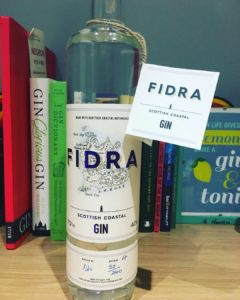 For those of you that know your Scottish islands, you might know of Fidra off of the coast of East Lothian. Fun fact – my Dad grew up near the border of East Lothian and we spent many a summer holiday eating ice cream on the beach in Musselburgh which is just along the coast. Emma and Jo set up Fidra Gin after their passion for gin developed and they wanted to showcase botanicals grown on the East Lothian coast. The botanicals used include sea buckthorn, elderflower, lemon thyme and rosehip, all handpicked from the local area. The proximity to the sea allows the botanicals to impart a slightly salty taste to the gin and their love for their area carries through to their branding, a beautiful tall, thin bottle with a label depicting the region. So, how does it taste?
For those of you that know your Scottish islands, you might know of Fidra off of the coast of East Lothian. Fun fact – my Dad grew up near the border of East Lothian and we spent many a summer holiday eating ice cream on the beach in Musselburgh which is just along the coast. Emma and Jo set up Fidra Gin after their passion for gin developed and they wanted to showcase botanicals grown on the East Lothian coast. The botanicals used include sea buckthorn, elderflower, lemon thyme and rosehip, all handpicked from the local area. The proximity to the sea allows the botanicals to impart a slightly salty taste to the gin and their love for their area carries through to their branding, a beautiful tall, thin bottle with a label depicting the region. So, how does it taste?
Biggar Gin
Note: I contacted Biggar for a sample and they kindly sent me one to try, as always I’ll let you know what I think.
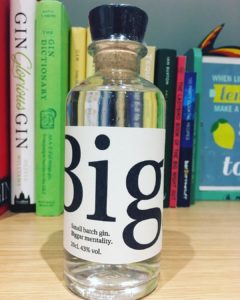 Biggar gin is one of the many new brands coming from Scotland, started by two brothers who focus on small scale production with big ambitions. They take their name from the town they grew up in, south of Glasgow and Edinburgh in the Southern Uplands and distil their gin at the famous Strathearn Distillery. Traditional botanicals juniper, coriander seeds, cardamom and orris root combine with rosehip, rowan berries and lavender. The idea behind the botanicals is to create a balance of flavours – sweet meets savoury, florals meet earthiness – which reflects the local landscape. So, how does it taste?
Biggar gin is one of the many new brands coming from Scotland, started by two brothers who focus on small scale production with big ambitions. They take their name from the town they grew up in, south of Glasgow and Edinburgh in the Southern Uplands and distil their gin at the famous Strathearn Distillery. Traditional botanicals juniper, coriander seeds, cardamom and orris root combine with rosehip, rowan berries and lavender. The idea behind the botanicals is to create a balance of flavours – sweet meets savoury, florals meet earthiness – which reflects the local landscape. So, how does it taste?
Fifty Pounds Gin
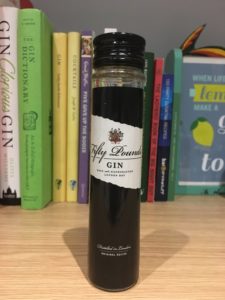 Fifty Pounds gin makes a bold claim. They say they are the “smoothest gin ever”. Distilled in south east London, the award winning gin is made in a small distillery and they triple filter it to achieve this smoothness. You might have seen Fifty Pounds gin before, their distinctive bottle is based on the first gin bottles from the 18th century, labelled with the batch and year it was made – possible due to the producing batches of only 1000 bottles. They keep their recipe secret but are quite open about their botanicals: Croatian juniper, coriander seeds, Spanish orange and lemon peel, and African grains of paradise amongst others. These are placed in the still with their neutral grain spirit and some water, are left to macerate then they gently heat them for the five hour distillation process. This is left for a minimum of three weeks which they say allows the essential oils from the botanicals to blend into the grain spirit. The final step in reaching their 43.5% ABV is to mix it with their neutral grain spirit and some pure water.
Fifty Pounds gin makes a bold claim. They say they are the “smoothest gin ever”. Distilled in south east London, the award winning gin is made in a small distillery and they triple filter it to achieve this smoothness. You might have seen Fifty Pounds gin before, their distinctive bottle is based on the first gin bottles from the 18th century, labelled with the batch and year it was made – possible due to the producing batches of only 1000 bottles. They keep their recipe secret but are quite open about their botanicals: Croatian juniper, coriander seeds, Spanish orange and lemon peel, and African grains of paradise amongst others. These are placed in the still with their neutral grain spirit and some water, are left to macerate then they gently heat them for the five hour distillation process. This is left for a minimum of three weeks which they say allows the essential oils from the botanicals to blend into the grain spirit. The final step in reaching their 43.5% ABV is to mix it with their neutral grain spirit and some pure water.
Chase GB gin
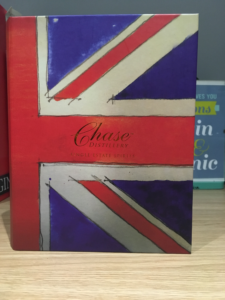 Because I am very lucky, I have lots of lovely friends and today I’m drinking Chase Distillery‘s GB gin. Chase Distillery came about after potato farmer William Chase had enough of supermarkets pushing up prices and feeling detached from his customers, so used his potatoes to make crisps. Tyrrells crisps to be precise. Whilst making these, he stumbled upon vodka made from a potato spirit, and thought that seemed like something fun to experiment with. Flash forward four years and they released their first batch of vodka. Ten years on, they have built a new distillery on their farm in Herefordshire making their own vodka, which in turn is the base for their gin. They use 10 botanicals to make their vodka shine, including juniper (obvs), cinnamon, ginger, almond, cardamom, cloves and lemon. Chase have a big focus on sustainability, they create energy from a bio-boiler using orchard prunings, their potato waste fertilises the fields and feeds their cows and grow many of their fresh ingredients themselves. So, how does it taste?
Because I am very lucky, I have lots of lovely friends and today I’m drinking Chase Distillery‘s GB gin. Chase Distillery came about after potato farmer William Chase had enough of supermarkets pushing up prices and feeling detached from his customers, so used his potatoes to make crisps. Tyrrells crisps to be precise. Whilst making these, he stumbled upon vodka made from a potato spirit, and thought that seemed like something fun to experiment with. Flash forward four years and they released their first batch of vodka. Ten years on, they have built a new distillery on their farm in Herefordshire making their own vodka, which in turn is the base for their gin. They use 10 botanicals to make their vodka shine, including juniper (obvs), cinnamon, ginger, almond, cardamom, cloves and lemon. Chase have a big focus on sustainability, they create energy from a bio-boiler using orchard prunings, their potato waste fertilises the fields and feeds their cows and grow many of their fresh ingredients themselves. So, how does it taste?
Tarquin’s Cornish Christmas Gin
 As per the last two years, I’ve received my Craft Gin Club delivery in December. Due to the daily blogging for Ginvent, I then never get to try it until after Christmas. But here we go; this month’s delivery contains an exclusive collaboration with Tarquin’s, one of my favourite distillers. I’ve tried many over the four years I’ve been writing, too many to list here but feel free to have a search back, and never have I been disappointed. This edition is only available to Craft Gin Club members and was distilled using a whopping 18 botanicals including Tarquin’s staple violet alongside Christmassy botanicals nutmeg, star anise, ginger and allspice. There’s also plenty of citrus fruits and tonka bean to bring a mulled fruit note to balance the zest and marzipan.
As per the last two years, I’ve received my Craft Gin Club delivery in December. Due to the daily blogging for Ginvent, I then never get to try it until after Christmas. But here we go; this month’s delivery contains an exclusive collaboration with Tarquin’s, one of my favourite distillers. I’ve tried many over the four years I’ve been writing, too many to list here but feel free to have a search back, and never have I been disappointed. This edition is only available to Craft Gin Club members and was distilled using a whopping 18 botanicals including Tarquin’s staple violet alongside Christmassy botanicals nutmeg, star anise, ginger and allspice. There’s also plenty of citrus fruits and tonka bean to bring a mulled fruit note to balance the zest and marzipan.
Ginvent 2018 – Scapegrace Gold Gin
 Happy Christmas Eve! It is with great sadness that we bring Ginvent to an end for yet another year, but before we do we need to try Scapegrace Gold gin. Scapegrace gin comes from New Zealand, when one guy married the other guy’s sister and discussed how they would like to make their own gin. 13 botanicals and a load of debt later, they had a gin that won gold in London and San Francisco. They use glacial water from the southern Alps mixed with orange and lemon peel, nutmeg, cloves and dried tangerine to make their classic 42% gin. Scapegrace Gold is their navy strength version at 57% which builds layers of citrus with orange, lemon and tangerine. So let’s see how it tastes.
Happy Christmas Eve! It is with great sadness that we bring Ginvent to an end for yet another year, but before we do we need to try Scapegrace Gold gin. Scapegrace gin comes from New Zealand, when one guy married the other guy’s sister and discussed how they would like to make their own gin. 13 botanicals and a load of debt later, they had a gin that won gold in London and San Francisco. They use glacial water from the southern Alps mixed with orange and lemon peel, nutmeg, cloves and dried tangerine to make their classic 42% gin. Scapegrace Gold is their navy strength version at 57% which builds layers of citrus with orange, lemon and tangerine. So let’s see how it tastes.
Ginvent 2018 – Pothecary gin
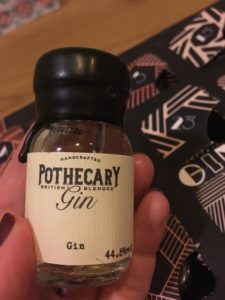 We’ve made it to the penultimate day of Ginvent. Sad face. Today we drink Pothecary gin, which I tried after meeting the team at Junipalooza earlier this year. You can read my thoughts on it here.
We’ve made it to the penultimate day of Ginvent. Sad face. Today we drink Pothecary gin, which I tried after meeting the team at Junipalooza earlier this year. You can read my thoughts on it here.
You can get your hands on a 50cl bottle from Gin Kiosk for £39 (at the time of writing). You can find them on Facebook, Twitter and Instagram.
Let me know your thoughts on Twitter and Instagram, and catch up with all things Ginvent here.
Ginvent 2018 – Malfy Gin
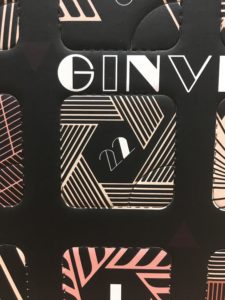 Final three days! Today we drink Malfy gin, an Italian gin with a lovely label. Most accounts of gin history trace the roots back to the Dutch genever, but Malfy claim that gin was invented by monks on the Salerno coast and their distillery in Moncalieri has been established since 1906. The key flavour for Malfy gin is the Italian lemons that grow in Sicily and the Amalfi coast. These lemons give the gin it’s freshness, alongside Italian grown juniper and fresh spring water. Since launching, they have grown their range to include four varieties – the Originale that we are drinking today which actually came second and is more juniper forward than the original the Con Limone which makes the most of the fresh lemons, the Con Arancia using Sicilian blood oranges, and the Gin Rosa which features pink grapefruit and Italian rhubarb. So, how does it taste?
Final three days! Today we drink Malfy gin, an Italian gin with a lovely label. Most accounts of gin history trace the roots back to the Dutch genever, but Malfy claim that gin was invented by monks on the Salerno coast and their distillery in Moncalieri has been established since 1906. The key flavour for Malfy gin is the Italian lemons that grow in Sicily and the Amalfi coast. These lemons give the gin it’s freshness, alongside Italian grown juniper and fresh spring water. Since launching, they have grown their range to include four varieties – the Originale that we are drinking today which actually came second and is more juniper forward than the original the Con Limone which makes the most of the fresh lemons, the Con Arancia using Sicilian blood oranges, and the Gin Rosa which features pink grapefruit and Italian rhubarb. So, how does it taste?